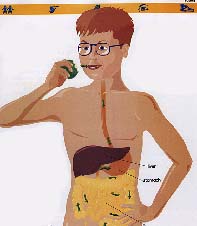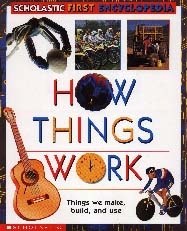|
________________
CM . . . .
Volume VII Number 18 . . . . May 11, 2001
Grades 2 - 4 / Ages 7 - 9.
excerpt: (from How Things Work.) A telephone is an electrical machine that is used to talk to people in another place. The sound of a person's voice doesn't travel very far on its own. A telephone uses electricity to change the voice into signals that flash along electrical cables, or cables made of optical fiber, to a telephone in another street or another country, all in a few seconds. Cordless telephones act like two-way radios. They change your voice into radio waves that travel to another telephone through the air.  Bright, colourful and chock full of interesting facts, these books, part of a six-title series, are
designed to introduce young students to beginning research. Each title contains a table of
contents, index, glossary and pronunciation guide. Topics are arranged alphabetically, with
a double-page spread devoted to each of them. Coloured bands, strewn with tiny symbols
representative of the title, appear at the top of each page, unifying both the book and the series.
Cross-referenced topics are listed above the bands. Text is fairly large and uses simple vocabulary,
giving youngsters just enough information to understand the concept without becoming too
technical. Excellent photographs, drawings and diagrams, all suitably labelled, enliven the text.
Boxes with fascinating facts also appear throughout each volume in the series. An attractive
layout, lively illustrations and age-appropriate information combine to make each book appealing
to children.
Bright, colourful and chock full of interesting facts, these books, part of a six-title series, are
designed to introduce young students to beginning research. Each title contains a table of
contents, index, glossary and pronunciation guide. Topics are arranged alphabetically, with
a double-page spread devoted to each of them. Coloured bands, strewn with tiny symbols
representative of the title, appear at the top of each page, unifying both the book and the series.
Cross-referenced topics are listed above the bands. Text is fairly large and uses simple vocabulary,
giving youngsters just enough information to understand the concept without becoming too
technical. Excellent photographs, drawings and diagrams, all suitably labelled, enliven the text.
Boxes with fascinating facts also appear throughout each volume in the series. An attractive
layout, lively illustrations and age-appropriate information combine to make each book appealing
to children.
After a brief introduction about how machines help people at home, at work and at play, How Things Work offers simple, basic explanations of everyday objects and their use. Topics range from structures, such as bridges and roller coasters, to vehicles, personal items (cameras, guitars, books) and the conversion of natural resources to usable forms of energy (oil and electricity). Suitable for children who have often wondered how a common object is produced or how it functions, this volume not only provides the answers but might also spark further research. Animals and Nature focuses on the major animal classifications and the animals which best exemplify each group. The elements, air, earth and water, as well as several habitats are also featured. Generally, very brief overviews of the topics are given along with some interesting facts, but certainly not enough information for even primary grade research. Sub-topics largely depend on what is unique about the animal- the butterfly's life cycle, for instance, or the difference between the snouts of crocodilians. Of the four titles, this one is the least comprehensive. Though the authors must have found it difficult to decide which topics to include, some of the categories are questionable. A few examples: why include "farm" in a book that discusses the natural environment? some habitats but not others? mountain but not volcano? and why a two-page spread on the universe when the main thrust of the book is animals? A First Atlas begins with a cross-section of the earth and explains how land masses have changed over time. There is a very rudimentary lesson on map reading - basically just legend (symbols and lines) - that helps youngsters to read the maps in each section of the book. Starting with Canada, the volume is then arranged by geographic regions of the various continents rather than by country. Large, colourful maps introduce each continent, followed by information on the regions - the lands of the Andes, West Africa and the Mediterranean, to name a few. The book provides a brief glimpse into the climate, animals, plants, land forms, economy, culture and history of specific countries, but this information is not uniform throughout the book. Rather, the focus depends on the country. In the information on the Amazon region, for example, the rainforest is featured, whereas Australia's claim to fame is her unique animals, both the interesting marsupials and the dwellers of the Great Barrier Reef. Most appealing are the wonderful photographs of the people and the natural and built environments. With its emphasis on the physical, emotional and social development of humans, All About People discusses such topics as body systems, the five senses, illness and healing, feelings, friends, family relationships and how people live: eating, drinking, learning, moving, sleeping and playing. Time lines for the main life stages highlighted are also provided along with general statements about the abilities and activities of humans at those stages. In contrast to the white backgrounds of the majority of pages, the backgrounds of those pages depicting a new life stage are brightly coloured, drawing attention to the topic and helping students to find the necessary information. Generally, a good beginning encyclopedia. Recommended. Gail Hamilton is a teacher-librarian at Bird's Hill School in East St. Paul, MB.
To comment on this title or this review, send mail to cm@umanitoba.ca.
Copyright © the Manitoba Library Association.
Reproduction for personal use is permitted only if this copyright notice
is maintained. Any other reproduction is prohibited without
permission.
Published by
TABLE OF CONTENTS FOR THIS ISSUE - May 11, 2001.
AUTHORS |
TITLES |
MEDIA REVIEWS |
PROFILES |
BACK ISSUES |
SEARCH |
ORDER |
CMARCHIVE |
HOME
|



